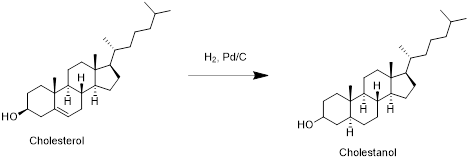
Concept explainers
(a)
Interpretation:
The product formed when cholesterol reacts with hydrogen in presence of palladium-carbon has to be drawn.
(a)
Explanation of Solution
Cholesterol with hydrogen:

Cholesterol reacts with hydrogen in presence of palladium-carbon to reduce double bond to single bond and forms cholestanol. Therefore, the product obtained is cholestanol which is shown in the above scheme.
(b)
Interpretation:
The product formed when cholesterol reacts with acetyl chloride has to be drawn
(b)
Explanation of Solution
Cholesterol with acetyl chloride:

Cholesterol reacts with acetyl chloride in which acetylation reaction take place at hydroxyl group and forms cholesteryl acetate. Therefore, the product obtained is cholesteryl acetate which is shown in the above scheme.
(c)
Interpretation:
The product formed when cholesterol reacts with sulfuric acid followed by heating has to be drawn.
(c)
Explanation of Solution
Cholesterol with sulfuric acid:

Cholesterol reacts with sulfuric acid in which removal of water molecule take place and forms cholestene. Therefore, the product obtained is cholestene which is shown in the above scheme.
(d)
Interpretation:
The product formed when cholesterol reacts with water in presence of acid has to be drawn.
(d)
Explanation of Solution
Cholesterol with water:

Cholesterol reacts with water in presence of water in which removal of water molecule take place and forms desired product. Therefore, the product obtained is is shown in the above scheme.
(e)
Interpretation:
The product formed when cholesterol reacts with peroxy acid has to be drawn
(e)
Explanation of Solution
Cholesterol with peroxy acid:

Cholesterol reacts with peroxy acid in presence of water in which reaction take place at double bond and forms
Want to see more full solutions like this?
Chapter 20 Solutions
Essential Organic Chemistry, Global Edition
- For Raman spectroscopy/imaging, which statement is not true regarding its disadvantages? a) Limited spatial resolution. b) Short integration time. c) A one-dimensional technique. d) Weak signal, only 1 in 108 incident photons is Raman scattered. e) Fluorescence interference.arrow_forwardUsing a cell of known pathlength b = 1.25115 x 10-3 cm, a water absorption spectrum was measured. The band at 1645 cm-1, assigned to the O-H bending, showed an absorbance, A, of 1.40. a) Assuming that water density is 1.00 g/mL, calculate the water molar concentration c (hint: M= mole/L) b) Calculate the molar absorptivity, a, of the 1645 cm-1 band c) The transmitted light, I, can be written as I= Ioexp(-xb), where x is the absorption coefficient (sometimes designated as alpha), Io is the input light, and b is the cell pathlength. Prove that x= (ln10)*x*c. (Please provide a full derivation of the equation for x from the equation for I). d) Calculate x for the 1645 cm-1 bandarrow_forwardI need help with the follloaingarrow_forward
- For a CARS experiment on a Raman band 918 cm-1, if omega1= 1280 nm, calculate the omega2 in wavelength (nm) and the CARS output in wavelength (nm).arrow_forwardI need help with the following questionarrow_forwardFor CARS, which statement is not true regarding its advantages? a) Contrast signal based on vibrational characteristics, no need for fluorescent tagging. b) Stronger signals than spontaneous Raman. c) Suffers from fluorescence interference, because CARS signal is at high frequency. d) Faster, more efficient imaging for real-time analysis. e) Higher resolution than spontaneous Raman microscopy.arrow_forward
- Draw the major product of the Claisen condensation reaction between two molecules of this ester. Ignore inorganic byproducts. Incorrect, 5 attempts remaining 1. NaOCH3/CH3OH 2. Acidic workup Select to Draw O Incorrect, 5 attempts remaining The total number of carbons in the parent chain is incorrect. Review the reaction conditions including starting materials and/or intermediate structures and recount the number of carbon atoms in the parent chain of your structure. OKarrow_forwardUsing a cell of known pathlength b = 1.25115 x 10-3 cm, a water absorption spectrum was measured. The band at 1645 cm-1, assigned to the O-H bending, showed an absorbance, A, of 1.40. a) Assuming that water density is 1.00 g/mL, calculate the water molar concentration c (hint: M= mole/L) b) Calculate the molar absorptivity, a, of the 1645 cm-1 band c) The transmitted light, I, can be written as I= Ioexp(-xb), where x is the absorption coefficient (sometimes designated as alpha), Io is the input light, and b is the cell pathlength. Prove that x= (ln10)*x*c d) Calculate x for the 1645 cm-1 bandarrow_forwardConvert 1.38 eV into wavelength (nm) and wavenumber (cm-1) (c = 2.998 x 108 m/s; h = 6.626 x 10-34 J*s).arrow_forward
 Chemistry for Today: General, Organic, and Bioche...ChemistryISBN:9781305960060Author:Spencer L. Seager, Michael R. Slabaugh, Maren S. HansenPublisher:Cengage Learning
Chemistry for Today: General, Organic, and Bioche...ChemistryISBN:9781305960060Author:Spencer L. Seager, Michael R. Slabaugh, Maren S. HansenPublisher:Cengage Learning Introduction to General, Organic and BiochemistryChemistryISBN:9781285869759Author:Frederick A. Bettelheim, William H. Brown, Mary K. Campbell, Shawn O. Farrell, Omar TorresPublisher:Cengage Learning
Introduction to General, Organic and BiochemistryChemistryISBN:9781285869759Author:Frederick A. Bettelheim, William H. Brown, Mary K. Campbell, Shawn O. Farrell, Omar TorresPublisher:Cengage Learning

